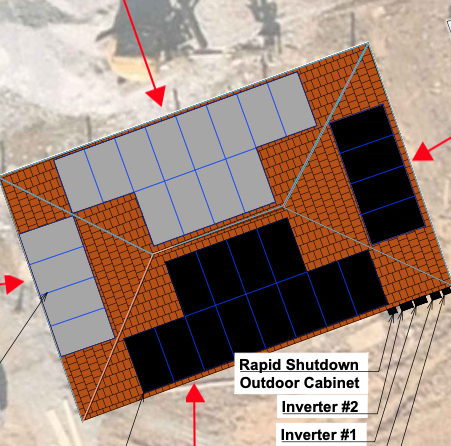I’ve been fighting with two identically installed Fronius Symo Advanced (10kW) inverters over the last month, and I think I’ve finally fixed it. It’s very strange, and seems to be an issue in the firmware of the inverter, itself.
The installation looks like this. They are two carports (only one is pictured), identically oriented, with north, south, east, and west arrays. The east and west arrays are smaller and hooked up to a Fronius Primo 3.8 on each carport, obviously using different MPPTs for different arrays. The same thing is the case for the north and south arrays: they’re hooked up to a Symo Advanced 10.0 at each carport.

The problem is that MPPT1, hooked up to the north array on each carport, drops off during high irradiance days. Check it out.

You can see when it starts producing in the morning, drops to nothing, then later in the day, it jumps back up and starts producing. Sometimes it takes until after noon, and sometimes, like pictured above, it comes back up when the irradiance dips and MPPT2 produces less for a bit.
This only happens on higher irradiance days with good, bright sun, and on both carports. On cloudier days, both north and south arrays on both carports produce equally, as you’d expect with diffuse sun.
Fronius tech support was no help with this one. We made sure firmware was up to date (fro34310 at the time, for those following along), but beyond that they were extremely confident that there was something wrong with our wiring or our array setup, but couldn’t give me proper direction. It may have simply been the one tech I was talking to, but he was extremely frustratingly not budging on his assessment. It doesn’t help that there are no error codes triggered with this problem.
In troubleshooting, I couldn’t nail any issues to our set up for rapid shutdown devices; everything on site is rated to work with each other and is set up properly. Had some previous issues with dueling RSD transmitters tripping arc faults that I got sorted, so very confident that’s not an issue any more.
When I was onsite, however, I was able to shut off DC to the inverter and turn it back on within about 10-20 seconds, and the inverter jumped up to the proper production on all strings, so it would seem there’s nothing instantaneous in the array that’s causing MPPT strangeness.
Finally, I swapped MPPTs between arrays, putting the south array (highest producing) on MPPT1 and the north array (lowest producing) on MPPT2. After giving it some time, I think this one change solved my issue.

You can see in comparison to the first graph, that the north arrays seem to have no more issues with dropping off in production. The south arrays didn’t have the irradiance on this day that they had in the previous graph, but it’s enough that the north arrays would have dropped off if they were wired as they were originally.
My reckon is that this is directly related to the inverter wigging out when MPPT2 gets 5x or more the production of MPPT1, and only resets when MPPT2 stops rising. I’d imagine that most installations would put the main and highest producing arrays on MPPT1 by default anyway, so this issue would be very rarely seen. If you’re having this issue, try making sure MPPT1 gets the most production between the two, and it might fix it for you.
Weird weird issue.

